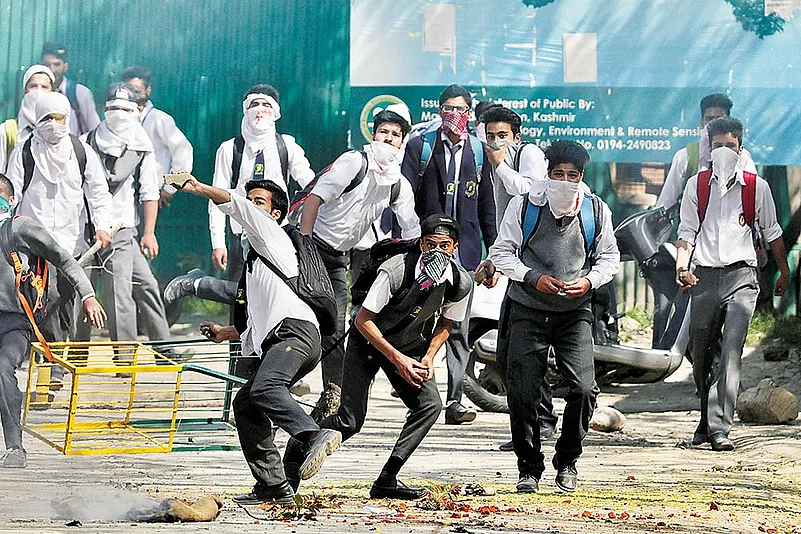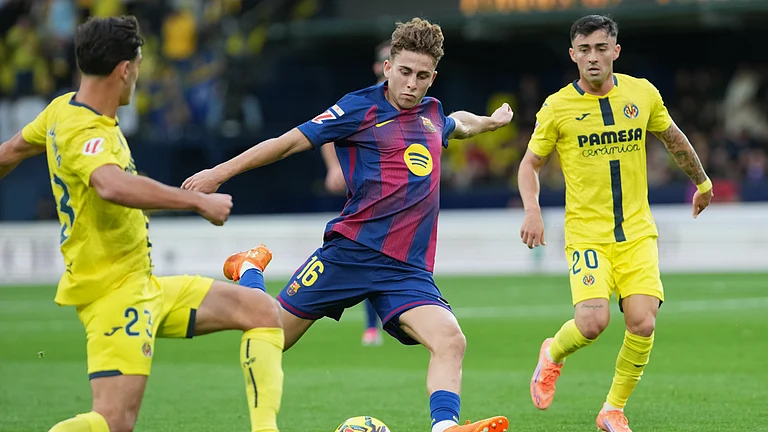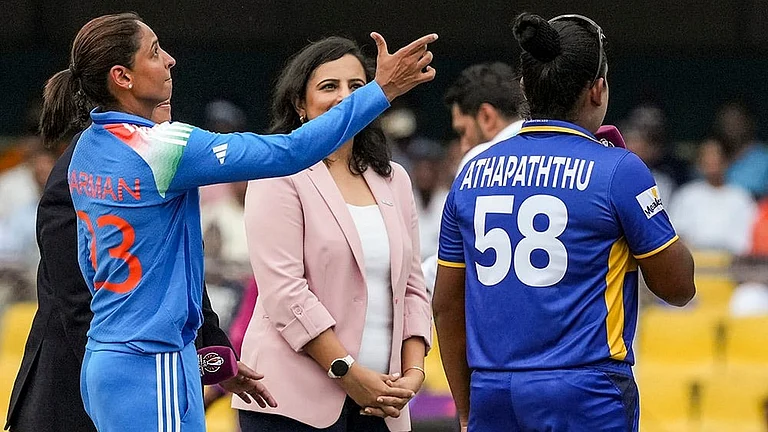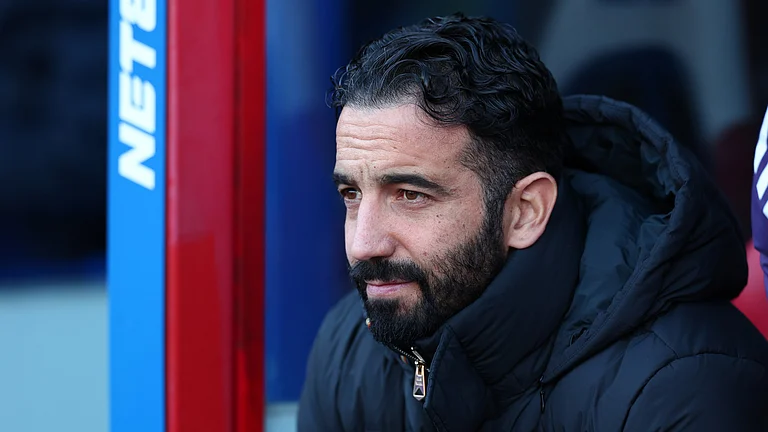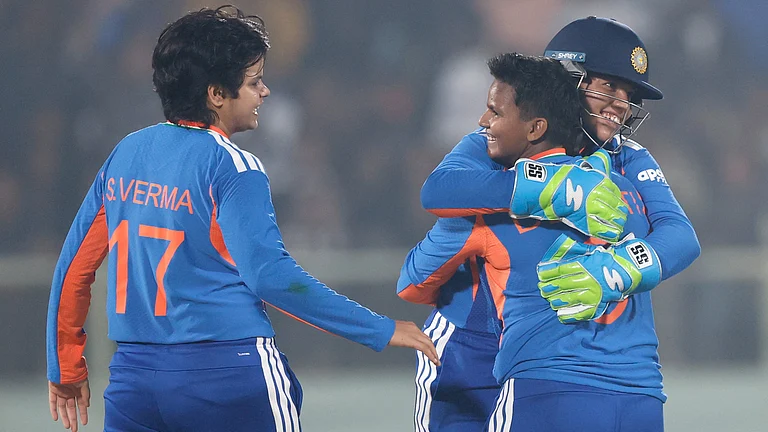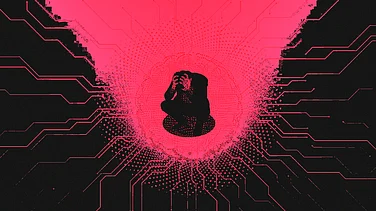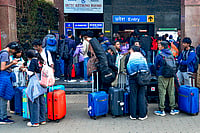Broken bricks and stones strewn outside the main gate of Government Degree College in Pulwama are what remain of April 15—the day when the college witnessed a pitched battle between the students and government forces. And on April 17, students across the Valley took to the streets in solidarity with the Pulwama students—the slogans raised were mostly pro-azadi, with some pro-Pakistan ones thrown in—forcing the PDP-BJP state government to order the closing down of all educational institutions. All in all, it capped a season of unrest that saw practically the entire landscape rise up in protest, prompting many to ask: what next in Kashmir?
In Pulwama, according to students, it started with the police and paramilitary forces cordoning off and entering the campus, aided by intense teargas and PAVA shelling. (PAVA is pelargonic acid vanillyl amide, also called nonivamide and is extracted from chilli pepper. It severely irritates the eyes and the respiratory tract, affecting breathing temporarily. In just six months of 2016, more than 1.60 lakh teargas shells and PAVA grenades were used to quell protests.) Showing some used teargas shells they claim to have picked up from various spots on the campus, students say the forces raided the college to “avenge” the defiance shown by them three days earlier (April 12) when they had pelted stones at an Indian army vehicle while it was entering the campus. According to Prof Abdul Hameed, the principal who has been removed from his post since, the students saw the army vehicle’s entry as the beginning of a raid and hurled stones at it.
Aamir Hameed Bhat, an operation theatre assistant, and Tanveer Ahmad Wani, an ambulance driver, were eyewitnesses to what happened. “I was not driving my ambulance into a college but a war zone,” recalls Aamir, 26, at Pulwama’s district hospital, just a kilometre from the college. “The police were firing teargas and PAVA shells, the boys were pelting stones, the girls crying in the classrooms and we brought around 64 students, including 40 girls, to the hospital in 25 rounds.”
As images of the injured girl students went viral, student protests erupted in every district of the Valley on April 17. At some colleges, especially in Srinagar, besides azadi slogans, the students also hailed Burhan Wani, the Hizbul Mujahideen commander whose killing by government forces on July 8 last year had triggered mass protests across the Valley. The government’s attempts to quell the six-month-long agitation had left nearly 90 civilians dead and over 15,000 injured. The slogans in the current spell of students’ agitation are an index of the unprecedented support for Kashmiri militants among the new generation—a symbolic stance of solidarity, whose very scale sets it apart from the more conflicted responses possible earlier. But why are things different now?
Some clues to the nature of things came a day before the students took to the streets, when a shutdown was observed on Sunday across the Valley to condemn the killing of a young protester by the BSF on April 14 in Srinagar’s Batmaloo area. At Shopian town, around 60 km south of Srinagar, nearly every shop was closed and the tension was palpable. The PDP’s Shopian town president, advocate Owais Ahmad Lone, says the situation alarms him. “Prime Minister Narendra Modi visits Kashmir and instead of talking about dialogue and reconciliation, he offers a choice: ‘terrorism or tourism’. Such an approach won’t work with the new generation,” says Lone. “Most militants here are locals. Many youngsters, including one of my friends, joined militant organisations as they were fed up with harassment by the police. As everyone knows them, it is natural that people rush to encounter sites to save them from the forces. If the government is keen on peace in Kashmir, it should stop killing protesters and start a dialogue.”
Lone didn’t quit the PDP even after militants barged into the houses of a fellow party leader and the families of six policemen at Chewan, 20 km from Shopian, on April 14, forcing them to announce they would shun pro-India politics and leanings. Locals say policemen are being targeted as the Special Operations Group (SOG), a part of the J&K Police, plays a key role in a lot of anti-militancy operations.
As a security measure, policemen have been officially instructed to not visit their homes during the next two months. Just a month ago, J&K DGP S.P. Vaid had responded to an incident where militants entered a police officer’s house in Shopian by warning militants: “This is between the police and the militants. Families should not be brought into this conflict.” It seems ideologically motivated, tech-savvy militants are getting the upper hand in the battle for minds, with social media becoming a major tool. Now, most militants operating in south Kashmir upload their pictures and videos on social networking sites to mobilise support and motivate other youngsters to join them—a trend that had started with Burhan Wani. The strategy is working. A typical incident happened on April 16 evening at Heff village near Shopian, where government forces had to call off an operation to capture a militant when a large number of people, mostly youth, rushed to the site. The militant managed to escape.
Giving a sense of the mood in south Kashmir, a protester tells Outlook that the infamous video clip of CRPF personnel being heckled at Budgam on April 9, the day of the Srinagar bypoll, was a “disgrace”. “The youngsters here would have snatched five guns from the CRPF and joined militant ranks,” he says as others nod in agreement. They add that other video clips—of Kashmiri youngsters being beaten or a man being tied to a jeep by the army as a human shield against stone-pelting—would only incite more anger, even though they show nothing new as “the forces have been doing all this since the 1990s”.

A Kashmiri on poll day
Senior police officials in Srinagar admit the situation is grim, but are wary of comparisons with the 1990s. According to police records, there are no more than 250 militants across the Valley, of whom around 100 are in south Kashmir and most are locals. Since January 2016, 105 locals took up arms, including 30 this year. In sharp contrast, according to home ministry records, there were around 6,800 militants in 1996. Former militant commanders say the figure was closer to 10,000 in 1995. The number fell over the years, with 4,390 militants arrested and 1,332 killed in 1995, and 3,453 militants arrested and 1,332 killed in 1996. The highest number of militants—2,421—were killed in 2001. Eventually, the army described 2015 as a “zero-infiltration year”. But by that time, the game was turning.
Top police officials say militants with guns are no big challenge compared to the “directionless and headless” protests that have become the order of the day, with even separatist leaders having little sway over the protesting youngsters. “J&K Police is not the same it was in the 1990s. It can deal with gun-toting militants, but the protests are an issue,” says a police official based in north Kashmir. Authorities in south Kashmir say the Election Commission took the right decision by postponing the Anantnag bypoll (earlier due on April 12) after large-scale protests and the death of eight people in firing around Budgam. This year, there have been 800 incidents of stone-pelting so far, leading to the death of 17 civilians in police firing.
According to police sources, militants adhering to competing ideologies are in the game—often against each other in their bid for popular support. On April 6, unidentified gunmen appeared in south Kashmir’s Karimabad village and actually warned the people against waving the Pakistan flag, justifying Taliban’s “war on the Pakistan government”. “This war is for Shariat or shahadat (martyrdom)…. Anyone who waves the Pakistan flag will be our enemy,” a militant said in a speech that was recorded and circulated on social media sites. The United Jehad Council, a PoK-based conglomerate of militant outfits, soon clarified that “these gunmen who pretend to be militants don’t belong to any militant outfit”. But it’s a sign of a booming market for sympathies at any rate.
A section of police officials see the current protests as a response to the “growing right-wing Hindu extremism in mainland India” and “loose talk” by politicians such as BJP MP Subramanian Swamy, who suggested “depopulating” Kashmir as a solution to recurrent protests. A PDP leader attributes it to his party’s alliance with the BJP, which made “people feel the PDP has betrayed them”.
A senior intelligence officer of J&K Police says protesters can be controlled without causalities, but it involves the risk of creating security arrangements that remind people of the 1990s. “On April 13, when repolling was conducted in 38 booths of Srinagar constituency, there was only two per cent turnout but no violence. We overwhelmed the area with the police and paramilitary forces. The sheer numbers frighten protesters and they run away,” he says with a guffaw. “If we adopt the same tactics elsewhere, the Valley will again look like the 1990s, full of bunkers and security forces.” Crowd control has indeed become a challenge. “Now, the question is how to avoid civilian causalities during anti-militancy operations and whether the army would agree to carry crowd-control weapons such as teargas and PAVA shells or pellet guns,” says a police official in Srinagar.
With the traditional separatists being seen to have little control over the protests, veteran separatist leader Prof Abdul Gani Bhat concedes, “We are in trouble. It can take any form.” Citing the presence of China in PoK and its growing involvement in the region through the China Pakistan Economic Corridor, Bhat hopes sooner or later India will hold talks to address the issue. Political commentator Gowhar Geelani, though, believes a government led by PM Modi is unlikely to hold talks. “The BJP government has decimated the mainstream pro-India regional parties, especially the PDP, with an eye on the 2019 general election, to appear more nationalistic,” says Geelani. “So much so, the National Conference (NC) is accusing the PDP of being the BJP’s creation.”
With the PDP allying with BJP even after fighting elections against it in 2014, the party is so demoralised today that it is wary of holding bypolls in its bastion in south Kashmir, which, until last year, had Mehbooba Mufti as MP. The PDP had perhaps expected a “Vajpayee-like approach” from Modi. In 2003, the then PM Atal Behari Vajpayee had travelled to Srinagar and called for talks with all political factions. “Hum inn sabke saath insaniyat ke daayre mein baat karenge (We will talk to everyone within the framework of humanity),” he had said. This unusual outreach by Vajpayee led to dialogue between the Hurriyat Conference led by Mirwaiz Umer Farooq and the NDA government. There have been no such overtures this time. No wonder, since the coalition took shape in March 2015, the PDP, which espoused “soft separatism” once upon a time, has not even raised the slogan of “self-rule”, but only asked for dialogue. And that too the BJP has spurned.
During his visit to the state on November 7, 2015, Modi made no mention of friendship with Pakistan or dialogue with separatists. Again, in Jammu on April 3 this year, in Mehbooba’s presence, the PM urged the youth of the Valley to choose between “tourism and terrorism”, saying “40 years of bloodshed” has not done anyone any good.
The policy drift of the Congress consisted of sending interlocutors in times of crisis and then not acting on their recommendations. The BJP, by contrast, is even more hands-off. It won’t engage with either the separatists or the pro-India political forces—an approach that seems to have pushed the latter to the other extreme. For instance, NC spokesman Junaid Azim Mattu says, “We will not accept the killing of protesters and the humiliation of Kashmiris such as tying a man to an army jeep. We will go for the kill now.”
With pro-India NC ready to “go for the kill”, PDP discredited, the separatists clueless and the students out in the streets protesting, Kashmir is sitting on a powder keg. All it needs is a trigger, which could be another army vehicle trying to enter a campus.
By Naseer Ganai in Pulwama and Shopian






